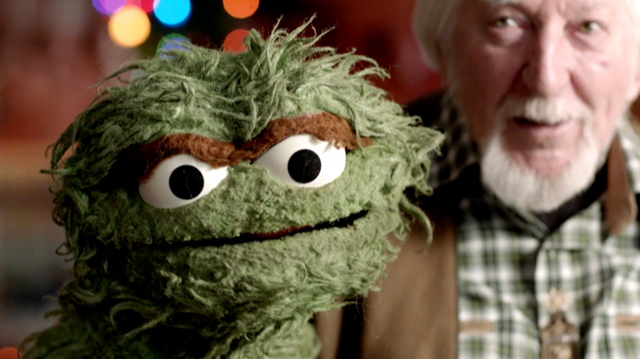When a David morphs into a Goliath, it often becomes difficult to make out the former insurgent in the current icon. But HBO’s new documentary, “Street Gang: How We Got to Sesame Street,” strives to do just that with the half-century-old television institution, recalling the noble objectives that gave the program life, as well as the crucial innovations that made it a touchstone of American childhood.
“Street Gang” treats “Sesame Street” – now first-run on HBO Max, then on PBS – like an old-fashioned superhero, endowing it with an underdog’s origin story, a purity of character and a striking lack of dimension. Adapted from author Michael Davis’s history of the series by director Marilyn Agrelo, “Street Gang” premiered at this year’s Sundance Film Festival. But it has the overwhelming feel of a cross-promotional puff piece, its endless sunny days and clouds away gradually resulting in a breakdown of momentum and structure.
As deliberately paced as “Sesame Street” itself (perhaps overly so for younger viewers), “Street Gang” is more engaging in its first half, in which the process of the show’s formation provides a natural narrative scaffolding.
The backdrop is a city riven by class and race: The seed for the show came out of a 1966 dinner party attended by TV producer Joan Ganz Cooney and Carnegie Corporation executive Lloyd Morrisett, who wondered how television might help young Black and brown children of what was then termed the inner city become as prepared for school as their white counterparts. Kids were already parked in front of the “idiot box” for hours and absorbing everything they saw, so why not numbers and letters, too?
Astoundingly in retrospect, “Sesame Street” became the first show to pair TV writers with educators – the combination that became the first iteration of the Children’s Television Workshop (now known as Sesame Workshop). According to “Street Gang,” Cooney’s influence was soon rivaled by those of the show’s first producer, Jon Stone, and puppeteer Jim Henson, then an advertising creative with little interest in kids’ entertainment. It was Henson who came up with the program’s most defining image: that of his colorful creations on the streets of New York City, interacting with adults and (nonprofessional) children alike.
After introducing the “characters” of Cooney, Stone and Henson, “Street Gang” offers little insight into how they worked together, and even less about how they interacted. (Only Cooney, now 92, survives among that original trio; Stone and Henson died in the 1990s.) Similarly, we learn practically nothing about the tensions between the writers and the educators, or what the Madison Avenue techniques in service of education – so touted in the press at the time – actually were. Nor do we come to understand very much of how the seemingly white-dominated producers thought about the need for on-screen or behind-the-scenes talent of color, especially considering the show’s explicit aim to appeal to Black and brown preschoolers.
There’s nothing less necessary than a gratuitously dirt-digging “exposé” of “Sesame Street.” But “Street Gang” isn’t too far behind in its inessentialness, the film’s celebratory superficiality increasingly grating as the doc goes on. Its aversion to addressing creative conflicts, for example, gives audiences scant appreciation for what ended up on screen and why. Though we get a primer on the origins of the show’s name, Agrelo offers practically no details about elemental facets of the show, such as its theme song and character design. And given the potential passivity of watching television, the film would’ve been bolstered by studies confirming the success of the show’s ambitious educational mission.
“Street Gang” is particularly laudatory about the series’ milestones in race, resulting in some of the film’s most frustrating segments. “Sesame Street” was a model of racial integration in its early years – an achievement that got it banned in at least one Mississippi media market. But a brief section on the Black-coded character Roosevelt Franklin – a purple-felt creation by Black cast member Matt Robinson (who also played Gordon) and the target of a letter-writing campaign by unhappy Black parents – underscores the film’s preference for gloss over analysis. Agrelo also praises the series’ inclusion of Latino characters like Luis (Emilio Delgado) and Maria (Sonia Manzano), without noting, as Davis does in his book, that they were the result of protests about the show’s lack of brown characters. (For their parts, Delgado voices pride in his stereotype-busting role as a small-business owner, and Manzano remembers the enormous creative input she was allowed by Stone.)
A rudderlessness sets in in “Street Gang’s” latter half, with the doc flitting through seemingly random topics, such as Henson and his longtime collaborator Frank Oz’s penchant for goofing around on set, the show’s celebrity musical guests and the assertions that the show overstimulated kids, which are touched on by Agrelo. Talking-head interviews with “Sesame” veterans are many but seldom truly revealing. The archival and behind-the-scenes footage is appealingly edited (by Ben Gold), offering some sense of what early episodes looked like. (A call-and-response performance of “I Am – Somebody” between the Rev. Jesse Jackson and a mixed-race group of children is a highlight.) Ultimately, though, the visual charm of legends at work and the series’ rough drafts is ultimately in service of a studiously uncomplicated account.
There’s plenty to commemorate and feel good about a show as eternally earnest and endearing as “Sesame Street,” the kind of program whose existence feels both destined and miraculous. But “Street Gang” won’t approach the well-roundedness of Bert and Ernie – never mind the unvarnished forthrightness of Oscar the Grouch.
Street Gang: How We Got to Sesame Street airs on HBO.
Send questions/comments to the editors.


